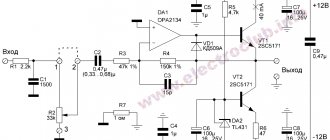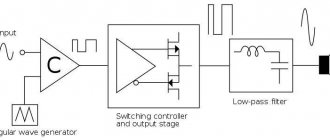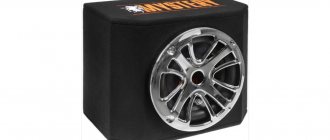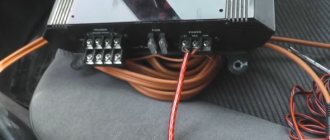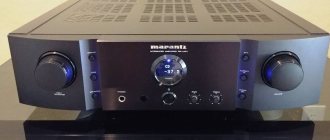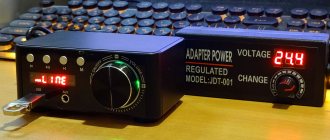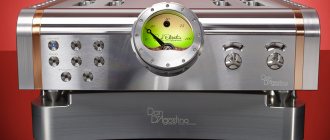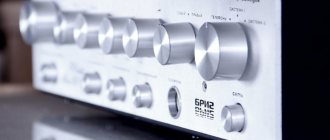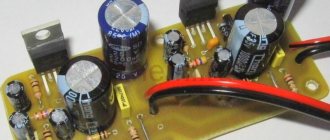Everything has its beginning, and if we are talking about amplifier operating modes, the origins are, of course, class A. It is with this that the history of amplifiers in particular and electronic audio in general began. Everything that came before had nothing to do with electronics, and indeed nothing to do with electricity, and everything that came after is easiest to understand if you know how class A amplifiers work. Well, the most surprising fact: despite the fact that this circuitry has already managed to achieve its centenary, it is still in demand and competes on equal terms with the most advanced circuit solutions of the 21st century.
Principle of operation
Back in 1916, the Swedish scientist Ernst Alexanderson, who worked for the American company General Electric, received a patent for an amplifier circuit, which is known throughout the world as class A. The operating principle of a class A amplifier is extremely simple, and to create an amplifier of this type, one transistor or one lamp is enough . To understand how it works, let's consider a more classic solution: a lamp.
Directly in the process of amplifying the sound signal in a radio tube, three structural elements are involved: anode, cathode and grid. When power is applied to the circuit, a flow of electrons occurs between the cathode and anode, and the grid located between them acts as a control valve.
If there is an electrical potential on the grid, it prevents the free passage of electrons, and the higher the electrical potential on the grid, the fewer electrons pass from the cathode to the anode until the lamp is completely closed. Thus, by connecting the payload (the acoustic system) between the cathode and the anode and applying a signal to the control grid, we get the simplest power amplifier circuit.
The specificity of an amplifier that works with an audio signal is that the sound wave has a symmetrical shape with positive and negative components equal in amplitude.
When such a signal is applied to the input of the amplifier, the following will happen: at the moment the positive half-wave passes, the lamp will open and close so that the output signal follows the shape of the sound wave at the input. But at the moment when the negative part of the half-wave arrives at the input, the grid will already be completely locked, and instead of playing sound at the output of the amplifier, we will get silence.
Despite the fact that in the article we are talking mainly about class A tubes, transistors are also capable of operating accordingly, and in the picture above you can see a standard circuit
In order to give the tube the ability to reproduce both halves of the signal, Ernst Alexanderson arranged for the zero point of the incoming signal to be shifted relative to the zero point (fully closed state) of the tube to approximately the middle of its operating range. Thus, the average position of the sound wave corresponded to the half-open state of the lamp.
At the moment the positive half-wave of the incoming signal passed, the lamp opened even more, and when the negative half-wave was reproduced, it closed, but partially, not reaching the minimum mark.
Overview of species
Acoustic systems have different parameters and areas of use, and therefore the amplification device has a number of types. By power there are:
- preliminary, which are a transitional link;
- terminal, directly increasing power;
- integral, connecting both previous modifications into a single device.
On an elemental basis they are divided into:
- lamp;
- transistor;
- integral platforms.
Based on the number of connected channels, devices are divided into:
- single-channel devices;
- two-channel device;
- four-channel;
- multi-channel amplification devices.
An important aspect of the classification is the scope of use of the device:
- car audio amplifier;
- home audio systems;
- concert equipment;
- studio equipment.
pros
At first glance, the scheme is quite nice and has a number of undeniable advantages. Firstly, it is simple, concise and is an excellent example of an extremely short audio path. Secondly, a lamp or transistor operating in class A is constantly in operation and instantly responds to changes in the incoming signal - they do not have the time delays that occur when leaving a completely closed state.
Third, the middle of the operating range of an electronic component is the zone in which it operates most efficiently and without distortion. This means that if you do not increase the amplitude to the maximum values (do not turn the volume knob particularly hard and do not connect a heavy load to the amplifier), the amplifier will operate exclusively in comfortable mode, and the output signal will have an almost ideal appearance.
Unfortunately, all these advantages without side effects can only be realized in low-current pre-amplifier circuits. And when it comes to working at the power required to interact with speaker systems, class A shows its equally obvious disadvantages.
Which stereo amplifier is better
High sound quality is what professional musicians, music lovers, or those who work with sound recordings strive for. You can achieve the best detailed sound by using a power amplifier.
This technique has many characteristics that are difficult for the average user to understand. So that the buyer can choose the best option, we have compiled our rating of stereo amplifiers. It included:
- Cambridge Audio AXA35, which supports a wide range of functions, is equipped with a phono preamplifier and is easy to use;
- High-quality professional SMSL A6 with simple controls, rich natural sound, minimal distortion;
- A budget version of Dynavox Spark II without unnecessary features, providing good sound.
Each nominee will receive positive feedback from ordinary users, musicians, and specialists. Since there are models from different price ranges, any buyer can choose the right amplifier.
Minuses
The main disadvantages of class A, as well as the advantages, stem from the operating principle chosen by the creator. The zero level of the input signal falls in the middle of the operating range of the electronic component, which means that when there is silence at the input, the transistor or lamp is already half open and operating at half its power, wasting a lot of energy. The real efficiency of class A amplifiers turns out to be significantly lower than the theoretical 50%. Of the 100% energy consumed by the amplifier, the acoustics receive no more than 20–25%, and all the remaining energy is converted into heat.
An increase in operating temperature can negatively affect the operating mode of the amplifying element; therefore, class A transistor amplifiers that produce any significant power have huge radiators.
If you want to get not tens, but hundreds of watts of power at the output, while maintaining the operating mode of the amplifier in class A, prepare a larger room and more powerful ventilation for heat removal, because due to the low efficiency, the amplifier itself will be huge, and its power supply will be completely colossal.
All this is followed by a number of related problems. Before the lucky owner of a Class A amplifier gets his first huge electric bill, he will have to spend a lot of money on the amplifier itself, because large power supplies, heavy tube output transformers and massive heatsinks of transistor amplifiers themselves cost money.
During operation, following increased energy costs, the audiophile will sooner or later encounter another problem with class A amplifiers - increased wear of the active elements of the circuit. This problem especially concerns lamps. Working in class A, they are constantly under heavy load, which reduces their already small work resource.
Operating principle
The operation of sound amplification equipment is based on the conversion of the energy received by the amplification element from the power source into the energy of the amplified input signal.
Main stages:
- The input from the sound source receives a signal, which is pre-amplified at the first stage and sent to the amplifier without distortion. The volume control is also located here. In this case, the quality of the original sound should not be lost.
- In the second stage, the driver stage, the signal is prepared for transmission to the final stage.
- The third most powerful cascade is connected to speakers that reproduce sound at the required volume without distortion.
Peculiarities
Understanding how a Class A amplifier works, we can look at it from an audiophile point of view. The situation with distortion at low volume levels is quite understandable: while the signal amplitude is not high, the amplifier operates in ideal conditions and provides the output, if not an absolutely perfect signal, then something as close as possible to it. But the question arises: what happens when we turn the music up louder?
Up to a certain point, it’s okay, but as soon as the signal peaks approach threshold values (the maximum open and closed state of a lamp or transistor), distortion will increase significantly, like with any other amplifier, after which compression will occur with distortion going beyond all imaginable levels. normal limits.
Someone will note that any amplifier can be overloaded and distorted. This is true. But the subtlety of the point is that class A amplifiers are, by definition, low-power, which means bringing them to the maximum load is not difficult. This is what happens in those moments when an amplifier that has just reproduced quiet chamber music with an incredible level of detail suddenly dumps the louder sound of a symphony orchestra into an unintelligible mess.
The next specific feature of the circuitry concerns the power supply. This, by the way, is one of the most important components of any amplifier, because the energy entering the acoustics is the energy of the power supply, modulated by the incoming signal. To put it in more understandable automotive terminology, the power supply is the engine, and the amplifier circuit is the steering wheel.
So, the low efficiency of a class A amplifier and high quiescent current drives the power supply into rather difficult conditions: it must have a substantial power reserve so that, while delivering a constantly high current, it can be ready to instantly deliver many times more. After a sharp surge in the signal, the capacitors of the power supply need to charge, that is, take additional energy from the transformer, which is already constantly tasked with maintaining a high quiescent current of the amplifier.
Not all power supplies are capable of coping with this task without side effects, so if the sound of a powerful amplifier operating in class A seems slow to you, fast music is blurred, and the bass is invariably booming and spread out over time, don’t be surprised and don’t rush blame it on the acoustics or its poor placement in the room.
Comparison table of technical characteristics
In this rating we have collected the 10 best sound amplifiers.
| Model | Type | Circuit design | Dimensions (WxHxD) |
| Denon PMA-720AE | integrated amplifier, stereo | semiconductor | 434x121x308 mm |
| YAMAHA A-S301 | integrated amplifier, stereo | semiconductor | 435x151x387 mm |
| Pioneer A-30 | integrated amplifier, stereo | semiconductor | 435x128x360 mm |
| Marantz PM5004 | integrated amplifier, stereo | semiconductor | 440x105x369 mm |
| Cambridge Audio CXA60 | integrated amplifier, stereo | semiconductor | 430x115x341 mm |
| Model | Type | Circuit design | Dimensions (WxHxD) |
| Fiio Q1 Mark II | headphone amplifier, stereo | semiconductor | 59x99x13 mm |
| Fostex HP-A3 | headphone amplifier, stereo | semiconductor | 108x36x140 mm |
| Sennheiser GSX 1000 | headphone amplifier, stereo | semiconductor | 143x70x139 mm |
| Chord Electronics Mojo | headphone amplifier, stereo | semiconductor | 82x60x22 mm |
| OPPO HA-2 | headphone amplifier, stereo | semiconductor | 68x157x12 mm |
Below is a detailed description of each model.
Practice
Despite all the shortcomings and technical features, class A amplifiers are still produced by different manufacturers and form a very noticeable niche in the Hi-Fi equipment market, and to be precise - in the High End segment, where dimensions, power consumption, operating complexity and even price can be neglect the sound for the sake of His Majesty.
In addition, from 1916 to the present time, many talented engineers have been born who have found ways to significantly compensate for the above-mentioned problems.
An excellent example of the above is the Octave V 16 Single Ended tube amplifier. The words Single Ended in the name are translated as “single-ended”, which is a technical description of the operating mode of the lamps and, in fact, is synonymous with the concept of “class A”.
In order to invigorate the classic circuit design and bring the amplifier's performance characteristics closer to modern realities, Octave developers have implemented several original solutions that correct the operating mode. Adaptive three-stage amplifier mode control controls the amount of bias current based on the maximum amplitude of the incoming signal, so as not to keep the amplifier circuit in a high-power mode unnecessarily.
And when there is no signal at the input for more than two minutes, the Ecomode mode is activated, which reduces power consumption by up to 35%. Thus, an amplifier left unattended will not heat up the room to no avail.
The developers fought for sound quality no less than for energy efficiency, so they used high-tech transformers with magnetic field compensation, advanced pre-amplifier stages that expand the range of reproduced frequencies, as well as the most advanced stabilization circuits that eliminate noise and hum, which class A amplifiers enjoy demonstrated even with a slight deviation from operating parameters.
As a result, the amplifier can be used with completely different loads: from low-impedance acoustics to high-impedance headphones, without fear of damaging them or simply going beyond the operating mode. Tracking electronic circuits reconfigure the output stages automatically.
Reading this, it’s time to get inspired and decide that absolutely all problems have already been solved by modern engineers. But don’t rush, because you need to look at your passport details. And there a very specific picture emerges. With low levels of noise and distortion, having nearly two dozen kilograms of live weight and consuming up to 200 W from the network, Octave V16 Single Ended produces no more than 8 W per channel on acoustics with an impedance of 4 Ohms when using the most powerful lamps. This is quite enough for headphones, but where to look for suitable speakers?
How to choose
When choosing an amplifier for a car, you should not ignore certain parameters that play a rather important role. First of all, this is the power of the model. Manufacturers indicate rated and maximum power. It is the nominal indicator that you need to pay attention to. In most cases, trusted manufacturers provide a certificate indicating the serial number of the product and the power measurements made at the factory.
You also need to pay attention to the harmonic distortion coefficient, which is designated THD. The sound frequency will depend on this indicator, so the lower it is, the better. It’s better to ask to connect the device and listen to its sound.
The build quality and manufacturer should not be ignored. Trusted companies that have proven themselves in the market are unlikely to disappoint in the future. Also, certain models may be designed for installation in a certain place, in this case, it is better to think in advance whether you will be able to mount the device in this part of the vehicle.
Sound
Since this text is part of a large series of publications devoted to various types of amplifiers, in the process of its preparation one large comparative audition was conducted, in which amplifiers of various classes participated. To give the listening experience a sufficient degree of objectivity, two models of floor-standing speakers were chosen.
One of them was a deliberately heavy load with low sensitivity - a large, tight bass driver, and required high power input. The second was intended to be the other side of the coin: an extremely light load that could work with any, even low-power, amplifier. And in all cases, this testing scheme was quite working until the Octave V16 Single Ended appeared on the scene with its 8 W per channel.
Under heavy load, the distortion was so real that it seemed you could touch it, and the load, previously known as light, successfully coped with the role of heavy. In the absence of another pair of speakers with a power of several watts and a sensitivity above 100 dB, headphones played the role of a light load.
With speakers that require at least 25 W according to their passport, the Octave V16 Single Ended worked surprisingly well. If you do not abuse the volume, you can fully appreciate the lively, open and clear sound, which is simply excellent on quiet audiophile recordings.
The situation becomes more complicated when it comes to more dynamic music, and on rock songs the amplifier happily dumps the sound of guitars into mush, giving as a bonus audible compression. The only saving grace is the fact that compression and distortion performed by tubes, unlike transistors, gives the sound a rather pleasant coloration.
If you try to reduce the load on the amplifier, lower the volume, and then sit closer so as not to lose sound pressure, the picture is corrected. There is no dirt, there are more parts, and compression is not felt. Here I will note that this amplifier is quite small in size; it can be placed not only in a rack, but even on a table, for use with headphones and near-field bookshelf monitors.
It was possible to fully experience the amplifier's belonging to the High End category through headphones. Absolutely crazy detail, open, spacious and timbre-rich sound, controlled and clear bass - everything you can dream of. And, characteristically, even with fast, heavy music, the amplifier began to behave with dignity. No imposingness, no mess, no booming in the low-frequency range. This is what it means to provide a class A amplifier with optimal operating conditions.
Criterias of choice
Independently choosing a suitable amplifier for an apartment that meets today's requirements and meets individual wishes is a difficult task. This is to some extent even an engineering task. It is necessary to take into account the parameters of the player and speaker systems that will be used in conjunction with the amplifier. And also additionally calculate the size and acoustics of the room where the musical equipment will be located and operated. And to top it all off, you need to decide on the costs, considering the level of quality that is acceptable to you.
There are several important points to consider.
- First of all, you need to assess the level of transient (linear) and intermodulation (nonlinear) distortions. Manufacturers do not indicate these values very often, and their presence in the passport indicates a thorough approach to the matter. For the best samples, the second value is no higher than 1%. Home installations have a satisfactory indicator of no more than 3%.
- When playing music, the speaker membranes undergo random vibrations. They are also called parasitic. An amplification device can counteract them. The success of this is assessed by smoothing - another numerical parameter, which for domestic use should be at least 100.
- Signal to noise ratio. This is when you set the volume control of the device to the limit and compare the amount of interference with the difference in the limits of the useful signal produced. The higher the number, the cleaner the sound will be.
- Frequency range. The more extensive it is, the better. It is especially good when this range goes into an area that is not perceptible to the human ear - this ensures operation without interference in the audible area. Of course, all else being equal.
- It is imperative to take into account the impedance and sensitivity of the speakers with which the amplifier will need to operate. Speaker systems with low sensitivity require a more powerful device. A lower acoustic resistance than that calculated for the amplification device can cause a short circuit and breakdown of the entire audio system. More, although it does not pose a danger, if the difference is significant, it can reduce the volume of the music being played.
- When asking about the number of playback channels, consider how many speakers you want to connect to the amplifier and in what way. Most amplifiers are 2-channel; it is possible to connect two speakers to them in mono or stereo mode. There are 4-channel samples, and in some, the number of channels can reach up to 8. Multi-channel models allow you to connect additional speakers to one amplifier. For example, a subwoofer is connected to a 4-channel. However, such amplifiers are more expensive than ordinary 2-channel amplifiers with equal power due to their more complex design.
And a few more additional recommendations.
- Selecting an amplifier modification does not always come down to its price and brand. Nevertheless, purchasing an overly inexpensive brand is also irrational - you shouldn’t rely on a miracle.
- You can purchase a device at retail outlets where you cannot test it only by first deciding on the selection of its modification.
- It is necessary to select a device for amplification with a power reserve so as not to “squeeze out all the juice” with a resource close to the maximum, since this immediately reduces its reliability. For example, a device with a maximum resource of 100 W guarantees long-term and reliable operation only at a power approximately 2 times less.
- In addition, you should focus on the size of the area where the sound-producing equipment will be used. The approximate power of each channel is 3-5 W per m2. When the space is no more than 15 m2, then you need to be guided by the first number, and when the space is more than 20 m2 - by the second.
- It is necessary to choose a device for amplification in which the speakers are connected not through spring latches, but through threaded terminals. This is the strongest fixation of the cords, moreover, it is some kind of indicator of the quality and involvement of the device in the Hi-Fi category.
In conclusion. It is not necessary to purchase the most modern modification. Sometimes a device that has been on a shelf or warehouse for a long time becomes much cheaper without deteriorating in performance.
For a video review of the Yamaha A-S201 amplifier, see below.
Resistors
A high-quality Hi-End tube amplifier is a retro device. Of course, the parts for its assembly must be appropriate. Instead of a resistor, a carbon and wire element may be suitable. If you spare no expense in developing this device, you should use precision resistors, which are quite expensive. Otherwise, MLT models are applicable. This is a pretty good element, as evidenced by the reviews.
Hi-End tube amplifiers are also suitable for use with BC resistors. They were made about 65 years ago. Finding such an element is quite simple; you just need to walk around the radio market. If you are using a resistor with a power of more than 4 Watts, you need to choose enameled wire elements.
Transformers
Another important point is the use of different transformers. As a rule, power and output are used, which must be connected perpendicularly. This way you can reduce the level of low-frequency background. Transformers should be located in grounded enclosures. It must be remembered that the cores of each transformer should also be grounded. There is no need to use shielded wire when installing devices to avoid additional problems. Of course, these are not all the features associated with installation. There are quite a lot of them, and it will not be possible to consider them all. When installing a Hi-End (tube amplifier), you cannot use new element bases. They are now used to connect transistors and integrated circuits. But in our case they will not work.
Types of amplifiers
So, there are three types of such equipment that make audio more powerful and louder:
Preliminary. If a device, such as a microphone, for example, deals with a poor sound source, the amplifier processes and improves the information about it, adding power.
Final. Actually, it only deals with its direct responsibilities - it amplifies the sound. Can be seen in recording studios among other professional equipment.
Integral. A mix of the previous two. The most widespread system available in stores. Like any combined solution, it gives slightly reduced sound quality compared to specialized amplifiers. But it wins in price and versatility.
The equipment is also distinguished by the method of signal transmission:
Analog amplifier. Works with electrical vibrations that it receives from the player, increasing their energy characteristics. To connect to digital technology, an appropriate converter is required.
Digital amplifier. Converts the digital signal at the output into an analog signal that is “understandable” to the speakers and adds power to it.
